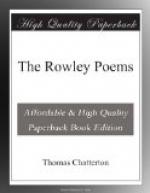At ten he was making progress in arithmetic, and it should be mentioned that he ’occupied himself with mechanical pursuits so that if anything was out of order in the house he was set to mend it.’ At school he read during play hours and made few friends, but those were ‘solid fellows,’ his sister tells us; while at home he had appropriated to himself a small attic where he would read, write and draw pictures—a number of which are preserved in the British Museum—of knights and churches, and heraldic designs in red and yellow ochre, charcoal, and black-lead. In this attic too he had stored—though at what date is uncertain—a number of writings on parchment which had a rather singular history. In the muniment room of St. Mary Redcliffe, the church in which Chatterton’s ancestors had served as sextons, there were six or seven great oak chests, of which one, greater than the others and secured by no fewer than six locks, was traditionally called ‘Canynges Cofre’ after William Canynge the younger, with whose name the erection and completion of St. Mary’s were especially associated. These had contained deeds and papers dealing with parochial matters and the affairs of the Church, but some years before Chatterton’s birth the Vestry had determined to examine these documents, some of which may have been as old as the building itself. The keys had in the course of time been lost, and the vestrymen accordingly broke open the chests and removed to another place what they thought of value, leaving Canynge’s Coffer and its fellows gutted and open but by no means void of all their ancient contents. Such parchments as remained Chatterton’s father carried away, whole armfuls at a time, using some to cover his scholars’ books and giving others to his wife, who made them into thread-papers and dress patterns.
In the house to which Mrs. Chatterton had moved upon her husband’s death there was still a sufficient number of these old manuscripts to make a considerable trove for the boy who, then nine or ten years old, had first learnt to read in black-letter and was in a few years to produce poetry which should pass for fifteenth century with many well-reputed antiquaries. It was no doubt on blank pieces of these parchments




